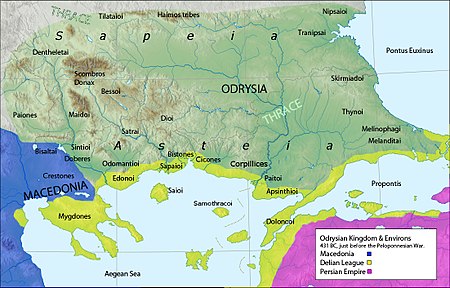
الموقع الإقليمي ل بيسيا، في الجبال والشمال الغربي من قبيلة دي (Dii).
بيسيا (/ˈbɛsaɪ/; (بالإغريقية: Βῆσσοι or Βέσσοι)) كانت قبيلة تراقية مستقلة تعيش في منطقة تمتد من مويسيا إلى جبال رودوب في جنوب تراقيا، ولكنها غالبًا ما تُذكر كمسكن حول هيموس (Haemus)، وهي سلسلة الجبال التي تفصل بين مويسيا من تراقيا ومن جبال رودوب إلى الجزء الشمالي من هبروس.[1] هيرودوت[2] وصفهم بأنهم نوع من الطائفة الكهنوتية بين الساتراي (Satrae)، البيسيا كان المفسرين للأقوال النبوية التي قدمتها كاهنة في أوراكل ديونيسوس الموجود على قمة جبل.
المراجع
- Harry Thurston Peck, Harpers Dictionary of Classical Antiquities (1898),"(Bessoi). A people of Thrace dwelling in a district known as Bessica, between Mount Rhodopé and the northern part of the river Hebrus."
- Herodotus, The Histories,7.111.1,"CXI. The Satrae, as far as we know, have never yet been subject to any man; they alone of the Thracians have continued living in freedom to this day; they dwell on high mountains covered with forests of all kinds and snow, and they are excellent warriors. [2] It is they who possess the place of divination sacred to Dionysus. This place is in their highest mountains; the Bessi, a clan of the Satrae, are the prophets of the shrine; there is a priestess who utters the oracle, as at Delphi; it is no more complicated here than there.1 ,Hdt. appears to mean that the method of divination is the “usual” one, as at Delphi; perhaps there were exaggerated accounts of the mysterious rites of the Bessi."
- (بالرومانية)
Lozovan, Eugen, Dacia Sacră, Editura Saeculum, Bucureşti, 2005.
- (بالفرنسية) 39, 1921, p. 288-290.
- Wilkes, John, The Illyrians, 1982, p. 84.
موسوعات ذات صلة :
Peeters, Paul, “La version ibéro-arménienne de l’autobiographie de Denys l’Aréopagite”, Analecta Bollandiana